- Clone
- 16A11 (See other available formats)
- Regulatory Status
- RUO
- Other Names
- KLRC1, NKG2B, NKG2AB6
- Isotype
- Mouse IgG2b, κ
- Barcode Sequence
- GTGTTTGTGTTCCTG
| Cat # | Size | Price | Quantity Check Availability | ||
|---|---|---|---|---|---|
| 142813 | 10 µg | $369.00 | |||
CD159a, also known as NKG2A or KLRC1 (killer cell lectin-like receptor subfamily C, member 1), is a 43 kD type II transmembrane protein with extracellular C-type lectin domains. It belongs to the killer cell lectin-like receptor family also known as the NKG2 family. It is expressed on NK and NKT cells and activated CD8+ T cells. NKG2A binds to non-classical MHC class I molecule Qa-1 and causes inhibition of NK cell-mediated target-cell lysis.
Product Details
- Verified Reactivity
- Mouse
- Antibody Type
- Monoclonal
- Host Species
- Mouse
- Immunogen
- C57BL/6 mouse CD94/NKG2A transfected CHO cells
- Formulation
- Phosphate-buffered solution, pH 7.2, containing 0.09% sodium azide and EDTA
- Preparation
- The antibody was purified by chromatography and conjugated with TotalSeq™-C oligomer under optimal conditions.
- Concentration
- 0.5 mg/mL
- Storage & Handling
- The antibody solution should be stored undiluted between 2°C and 8°C. Do not freeze.
- Application
-
PG - Quality tested
- Recommended Usage
-
Each lot of this antibody is quality control tested by immunofluorescent staining with flow cytometric analysis and the oligomer sequence is confirmed by sequencing. TotalSeq™-C antibodies are compatible with 10x Genomics Chromium Single Cell Immune Profiling Solution.
To maximize performance, it is strongly recommended that the reagent be titrated for each application, and that you centrifuge the antibody dilution before adding to the cells at 14,000xg at 2 - 8°C for 10 minutes. Carefully pipette out the liquid avoiding the bottom of the tube and add to the cell suspension. For Proteogenomics analysis, the suggested starting amount of this reagent for titration is ≤ 1.0 µg per million cells in 100 µL volume. Refer to the corresponding TotalSeq™ protocol for specific staining instructions.
Buyer is solely responsible for determining whether Buyer has all intellectual property rights that are necessary for Buyer's intended uses of the BioLegend TotalSeq™ products. For example, for any technology platform Buyer uses with TotalSeq™, it is Buyer's sole responsibility to determine whether it has all necessary third party intellectual property rights to use that platform and TotalSeq™ with that platform. - Application Notes
-
This product may be used for research purposes only. It is not licensed for resale and may only be used by the buyer. This product may not be used and is not licensed for clinical assays, where the results of such assays are provided as a diagnostic service. If a diagnostic or therapeutic use is anticipated, then a license must be requested from the University of California. The availability of such diagnostic and therapeutic use licenses cannot be guaranteed from the University of California.
- Additional Product Notes
-
TotalSeq™ reagents are designed to profile protein levels at a single cell level following an optimized protocol similar to the CITE-seq workflow. A compatible single cell device (e.g. 10x Genomics Chromium System and Reagents) and sequencer (e.g. Illumina analyzers) are required. Please contact technical support for more information, or visit biolegend.com/totalseq.
The barcode flanking sequences are CGGAGATGTGTATAAGAGACAGNNNNNNNNNN (PCR handle), and NNNNNNNNNCCCATATAAGA*A*A (capture sequence). N represents either randomly selected A, C, G, or T, and * indicates a phosphorothioated bond, to prevent nuclease degradation.
View more applications data for this product in our Scientific Poster Library. -
Application References
(PubMed link indicates BioLegend citation) -
- McMahon CW, et al. 2002. J. Immunol. 169:1444. (FC)
- Vance RE, et al. 2002. P. Natl. Acad. Sci. USA 99:868. (FC)
- RRID
-
AB_2941425 (BioLegend Cat. No. 142813)
Antigen Details
- Structure
- Type II transmembrane protein with extracelluar C-type lectin domains, complexed with CD94; 43 kD
- Distribution
-
NK cells and NK T cells from C57BL/6 mouse
- Function
- Inhibitory activity via ITIMs
- Ligand/Receptor
- Non-classical MHC-I molecule Qa-1
- Cell Type
- Embryonic Stem Cells, Mesenchymal Stem Cells, NK cells, NKT cells
- Biology Area
- Cell Biology, Immunology, Signal Transduction, Stem Cells
- Molecular Family
- CD Molecules, MHC Antigens
- Antigen References
-
1. Vance RE, et al. 1998. J Exp Med. 188:1841-8.
2. Lohwasser S, et al. 1999. Eur J Immunol. 29:755-61.
3. Sivakumar PV, et al. 1999. J Immunol. 162:6976-80.
4. Silver ET, et al. 1999. Immunogenetics 49:727-30.
5. Vance RE, et al. 1999. J Exp Med. 190:1801-12. - Gene ID
- 16641 View all products for this Gene ID
- UniProt
- View information about CD159a on UniProt.org
Other Formats
View All CD159a Reagents Request Custom Conjugation| Description | Clone | Applications |
|---|---|---|
| PE anti-mouse CD159a (NKG2AB6) | 16A11 | FC |
| Purified anti-mouse CD159a (NKG2AB6) | 16A11 | FC |
| APC anti-mouse CD159a (NKG2AB6) | 16A11 | FC |
| PE/Cyanine7 anti-mouse CD159a (NKG2AB6) | 16A11 | FC |
| TotalSeq™-A0927 anti-mouse CD159a (NKG2AB6) | 16A11 | PG |
| TotalSeq™-C0927 anti-mouse CD159a (NKG2AB6) | 16A11 | PG |
| TotalSeq™-B0927 anti-mouse CD159a (NKG2AB6) | 16A11 | PG |
Compare Data Across All Formats
This data display is provided for general comparisons between formats.
Your actual data may vary due to variations in samples, target cells, instruments and their settings, staining conditions, and other factors.
If you need assistance with selecting the best format contact our expert technical support team.
-
PE anti-mouse CD159a (NKG2AB6)
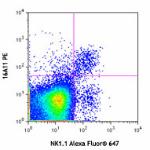
C57BL/6 mouse splenocytes were stained with NK1.1 Alexa Fluo... 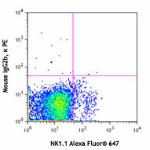
-
Purified anti-mouse CD159a (NKG2AB6)
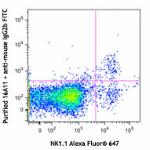
C57BL/6 mouse splenocytes were stained with NK1.1 Alexa Fluo... 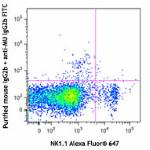
-
APC anti-mouse CD159a (NKG2AB6)
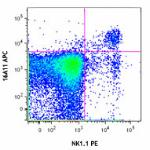
C57BL/6 mouse splenocytes were stained with NK1.1 (clone PK1... 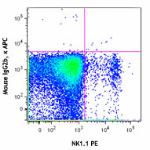
-
PE/Cyanine7 anti-mouse CD159a (NKG2AB6)

C57BL/6 mouse splenocytes were stained with TruStain fcX™ (c... -
TotalSeq™-A0927 anti-mouse CD159a (NKG2AB6)
-
TotalSeq™-C0927 anti-mouse CD159a (NKG2AB6)
-
TotalSeq™-B0927 anti-mouse CD159a (NKG2AB6)
